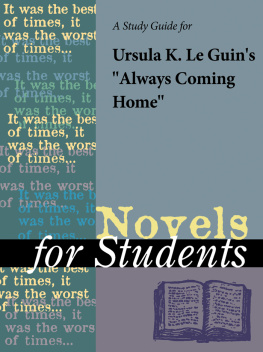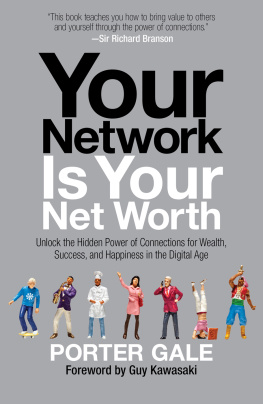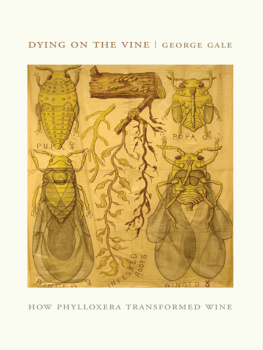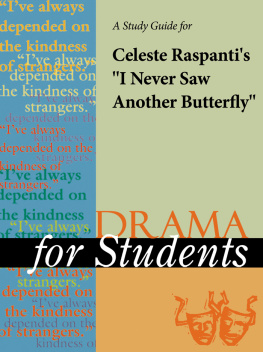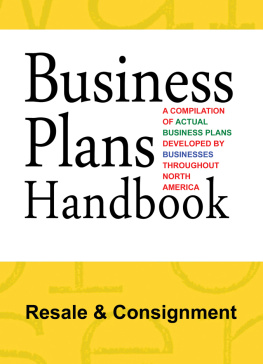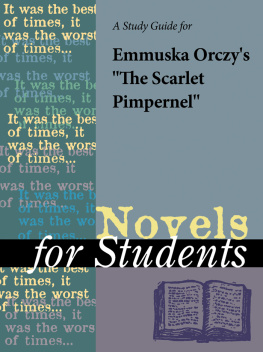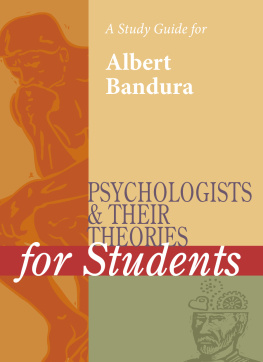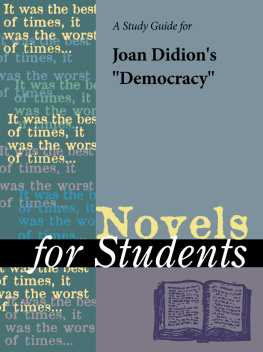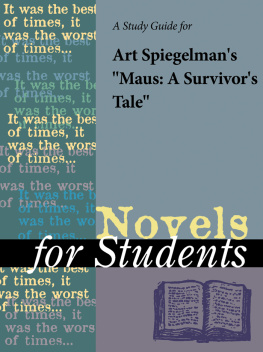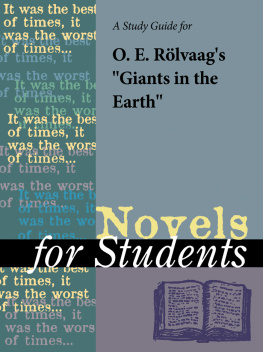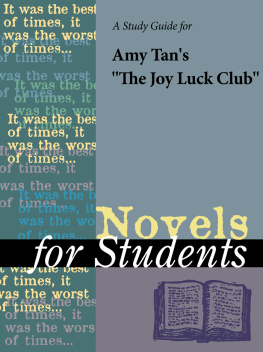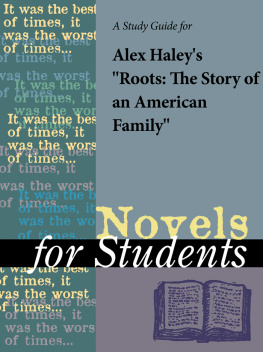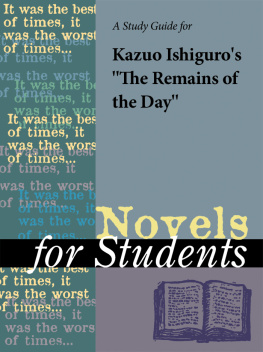TABLE OF CONTENTS
Guide
Novels for Students, Volume 9
Staff
Series Editors: Deborah A. Stanley and Ira Mark Milne.
Contributing Editors: Elizabeth Bellalouna, Elizabeth Boden-miller, Sara L. Constantakis, Catherine L. Goldstein, Motoko Fujishiro Huthwaite, Arlene M. Johnson, Angela Y. Jones, Michael L. LaBlanc, Polly Rapp, Erin White.
Research: Victoria B. Cariappa, Research Team Manager. Cheryl Warnock, Research Specialist. Corrine A. Boland, Tamara Nott, Tracie A. Richardson, Research Associates. Timothy Lehnerer, Patricia Love, Research Assistants.
Permissions: Maria Franklin, Permissions Manager. Margaret A. Chamberlain, Edna Hedblad, Permissions Specialists. Erin Bealmear, Permissions Associate. Sandra K. Gore, Permissions Assistant.
Production: Mary Beth Trimper, Production Director. Evi Seoud, Assistant Production Manager. Stacy Melson, Production Assistant.
Imaging and Multimedia Content Team: Randy Bassett, Image Database Supervisor. Robert Duncan, Imaging Specialist. Michael Logusz, Graphic Artist. Pamela A. Reed, Imaging Coordinator. Dean Dauphinais, Robyn V. Young, Senior Image Editors. Kelly A. Quin, Image Editor.
Product Design Team: Cynthia Baldwin, Product Design Manager. Pamela A. E. Galbreath, Senior Art Director. Gary Leach, Graphic Artist.
Copyright Notice
Since this page cannot legibly accommodate all copyright notices, the acknowledgments constitute an extension of the copyright notice.
While every effort has been made to secure permission to reprint material and to ensure the reliability of the information presented in this publication, Gale Research neither guarantees the accuracy of the data contained herein nor assumes any responsibility for errors, omissions, or discrepancies. Gale accepts no payment for listing; and inclusion in the publication of any organization, agency, institution, publication, service, or individual does not imply endorsement of the editors or publisher. Errors brought to the attention of the publisher and verified to the satisfaction of the publisher will be corrected in future editions.
This publication is a creative work fully protected by all applicable copyright laws, as well as by misappropriation, trade secret, unfair competition, and other applicable laws. The authors and editors of this work have added value to the underlying factual material herein through one or more of the following: unique and original selection, coordination, expression, arrangement, and classification of the information. All rights to this publication will be vigorously defended.
Copyright 2000
The Gale Group
27500 Drake Rd.
Farmington Hills, MI 48331-3535
All rights reserved including the right of reproduction in whole or in part in any form.
ISBN 0-7876-3828-5
ISSN 1094-3552
Printed in the United States of America.
10 9 8 7 6 5 4 3 2 1
Always Coming Home
Ursula K. Le Guin
1985
Introduction
Born in 1929, Ursula K. Le Guin has always enjoyed reading, especially poetry and fiction dealing with other times and places. Her parents were both professionals, her father an anthropology professor and her mother a children's literature author, and they both encouraged her literary aspirations. She says that she was lucky to be born in 1929 instead of 1939 because of J. R. R. Tolkien's influence. In her introduction to her critical exploration of science fiction, The Language of the Night: Essays on Fantasy and Science Fiction, Le Guin muses, "what would have happened if I had first read Tolkien in my teens, instead of my twenties. That achievement might have overwhelmed me." Tolkien's influence is most evident in Always Coming Home in its portrayal of a future possibility as an already established fact and presenting all aspects of this future culture in a scientific, textbook format. She began submitting stories for publication at age eleven and although she was not published that early, the real rejection slip from a real magazine only drove her desire for publication and fame.
Le Guin, in numerous interviews, never claims to be a science fiction/fantasy writer, but simply a novelist whose publishers market her work as science fiction/fantasy. When asked what kind of prize she would like to win, either a National Book Award or a Hugo, Le Guin said Nobel. She does not see a marked difference between writing fiction and writing science fiction. Both her academic training, including graduate work in French and Italian Medieval literature, and her desire to be a "name," have helped Le Guin carve out a unique position for herself in the second half of the twentieth century. She is one of the first women to reach national and academic acclaim in the genre of science fiction/fantasy. Beginning with her early "fairy tales in space suits" in the 1950s, Le Guin has produced over eighty novels and collections of short stories, storming the walls of both traditional science fiction readership and "serious" literary scholarship in an attempt to bring her version of feminist utopian ideology to a wider audience. Her success has inspired and encouraged the careers of other women science fiction writers like Amber Zimmer Bradley, Anne Macaffery, and Sheri Tepper.
Author Biography
Born in 1929, Ursula K. Le Guin has always enjoyed reading, especially poetry and fiction dealing with other times and places. Her parents were both professionals, her father an anthropology professor and her mother a children's literature author, and they both encouraged her literary aspirations. She says that she was lucky to be born in 1929 instead of 1939 because of J. R. R. Tolkien's influence. In her introduction to her critical exploration of science fiction, The Language of the Night: Essays on Fantasy and Science Fiction, Le Guin muses, "what would have happened if I had first read Tolkien in my teens, instead of my twenties. That achievement might have overwhelmed me." Tolkien's influence is most evident in Always Coming Home in its portrayal of a future possibility as an already established fact and presenting all aspects of this future culture in a scientific, textbook format. She began submitting stories for publication at age eleven and although she was not published that early, the real rejection slip from a real magazine only drove her desire for publication and fame.
Le Guin, in numerous interviews, never claims to be a science fiction/fantasy writer, but simply a novelist whose publishers market her work as science fiction/fantasy. When asked what kind of prize she would like to win, either a National Book Award or a Hugo, Le Guin said Nobel. She does not see a marked difference between writing fiction and writing science fiction. Both her academic training, including graduate work in French and Italian Medieval literature, and her desire to be a "name," have helped Le Guin carve out a unique position for herself in the second half of the twentieth century. She is one of the first women to reach national and academic acclaim in the genre of science fiction/fantasy. Beginning with her early "fairy tales in space suits" in the 1950s, Le Guin has produced over eighty novels and collections of short stories, storming the walls of both traditional science fiction readership and "serious" literary scholarship in an attempt to bring her version of feminist utopian ideology to a wider audience. Her success has inspired and encouraged the careers of other women science fiction writers like Amber Zimmer Bradley, Anne Macaffery, and Sheri Tepper.

